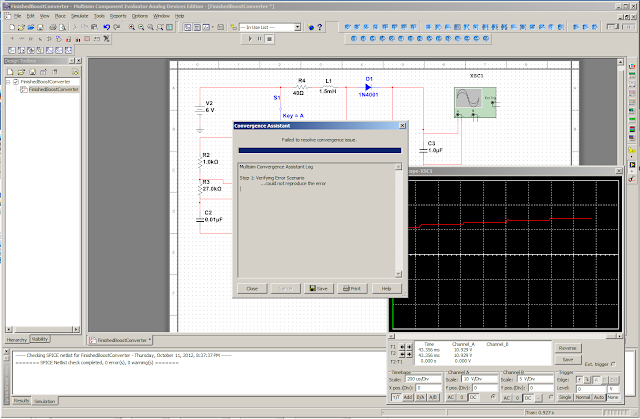Basic Idea
Boost Converters are circuits that increase the output voltage of a DC source. They do this by switching an inductor to charge and then by discharging it into a load. Since inductors store currents, their discharge voltages are theoretically indefinite.
 |
| Basic Boost Converter Circuit. Source: Wikipedia. Public Domain Work |
I will break down the different parts of the circuit and design each portion piece by piece.
Designing the Inductor Portion
Here I want to calculate charging times and maximum currents for this portion of the circuit. I'm going to assume a 6V source, 4 AA batteries.
 |
| RL circuit. Source: Wikipedia, User: Splash. Licensed under a Creative Commons Attribution-Share Alike 3.0 Unported license |
To make this a real circuit, I've decided to model my inductor off a cheap, off the shelf inductor, I'm choosing this first, because an inductor will be the most expensive component, so I want to design the circuit around it. The inductor I choose was a 1.5 mH inductor with a maximum current of 160 mA. It costs $0.85.
To meet the current constraint, I must use an appropriate resistance to keep amperage down below 160 mA with a 6V DC source. Therefore no less than 37.5 Ω can be used. I'm going to use 50 Ω to be on the safe side.
Based on that constraint, I want to determine how long it will take for the circuit to charge. It is generally agreed upon that 5 τ (time constants) is the time it takes to fully charge any circuit. In the case of an LR circuit, like the one I'm designing, τ = L/R. In this case Tau is 0.1857 ms. Therefor the switch must switch on for 0.1857 ms and off for another 0.1857 ms.
To meet the current constraint, I must use an appropriate resistance to keep amperage down below 160 mA with a 6V DC source. Therefore no less than 37.5 Ω can be used. I'm going to use 50 Ω to be on the safe side.
Based on that constraint, I want to determine how long it will take for the circuit to charge. It is generally agreed upon that 5 τ (time constants) is the time it takes to fully charge any circuit. In the case of an LR circuit, like the one I'm designing, τ = L/R. In this case Tau is 0.1857 ms. Therefor the switch must switch on for 0.1857 ms and off for another 0.1857 ms.
 |
| Simulation, in Multisim, of the basic RL charging circuit, showing charge times. |
Designing the Switch
No human can generate sub millisecond periods for a switch. Even if anyone could, why would they want to? We need to use an automated switching mechanism. For this I have chosen a BJT transistor, a voltage controlled current amplifier. This type of component, too is cheap, at $0.37 a part.
 |
| BJT transistor. Source: Mouser Electronics |
In the case of an NPN BJT a collector and emitter are used at the terminals of the switch, alternating voltage at the base is used to turn the switch on and off by bringing the transistor between saturation and cut-off modes.
 |
| Simulation, in Multisim, of transistor switch mechanism |
This is good, but there's still something I need: a waveform generator. In this simulation I'm using an idealized component, I need to make a real occilator.
Designing the Occilator
To supply the BJT's base with a waveform, I'll use a cheap 555 based oscillator circuit.
 |
| Square wave generator. Source: Next |
The core component of this circuit, the 555 timer, can be found for $0.29.
 |
| Simulation, in Multisim, of occilator |
After fine tuning, the period of this timer was made to match that of the charging and discharge times of the RL circuit.
Bringing it all together
Integrating the inductor, switching and occilator circuits, the final circuit looks like this.
 |
| Finished Boost Converter circuit in Multisim |
Here I put in a 1 MΩ load and a 1 microfarad capacitor to soften the voltage spikes out.
When I tried to simulate it, I ran into a non-descriptive error message.
 |
| Derp |
After pressing yes, I got this message.
 |
| Durr Hurr |
Despite these issues, I found that the simulator was able to simulate some of the circuit.
 |
| Finished Boost Converter in Multisim |
From that occiliscope output you can see the plot converging to about 14.5 V, more than twice the input voltage.
Conclusion
This circuit can be made fairly inexpensively with off the shelf parts. Such as:
- 1 1.5 mH inductor: $0.85
- 1 BJT NPN transistor: $0.37
- 1 Diode: $0.08
- 1 555 timer: $0.29
- 1 1k Ω resistor: $0.10
- 1 32 Ω resistor (in place of 40 Ω): $0.39
- 1 27K Ω resistor: $0.07
- 1 1M Ω resistor: $0.14
- 1 1 uF Capacitor: $0.17
- 2 0.01 uF Capacitors: $0.10
- 1 Vector board: $7.05
- 1 4 AA battery holder: $0.77
Total: $10.38
The Boost Converter can be used when high voltage is a priority over current, such as charging a capacitor to fire a camera flash, or to power nixie tubes that require high voltages but very little current.